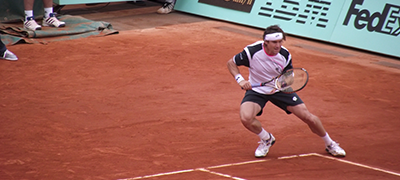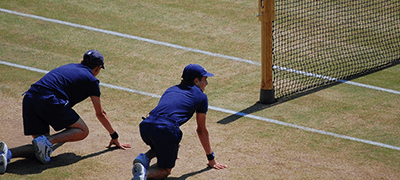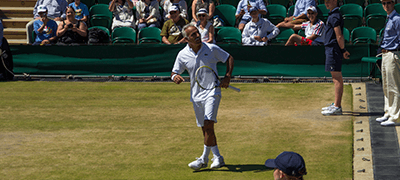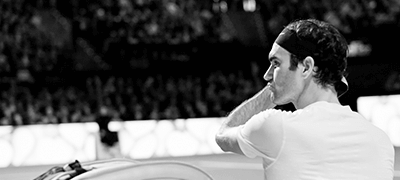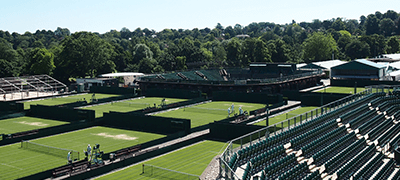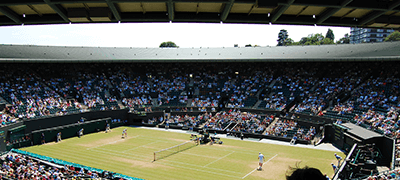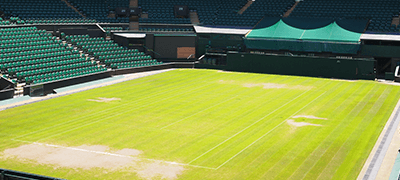The First Wimbledon & the story behind the trophies
Jul 27 6 min read
9:16 amIn 1868, London witnessed the establishment of the All England Croquet Club. Seven years later, members of the club realized the gradually diminishing interest in croquet was leading to the club’s financial instability. In 1874, Major Wingfield demonstrated his version of Lawn Tennis, then know as Sphairistike. In order to supplement the club’s revenue the Lawn Tennis Club was founded in 1875. New members joined and the financial hardships disappeared. The club spent only £25 to convert a croquet lawn into a tennis court.
The lush green ryegrass beautified the surface of Wimbledon. The pony roller which was invented in 1830, gave the courts of Wimbledon their unique aesthetic. But, a blessing in disguise took place in 1877, when the roller malfunctioned. The Lawn Tennis Club decided to organize a lawn tennis tournament to collect funds for the repair of the roller. Thus, the following announcement was posted.
LAWN TENNIS CHAMPIONSHIP
The All England Croquet and Lawn Tennis Club, Wimbledon, propose to hold a lawn tennis meeting, open to all amateurs, on Monday, July 9th and following days. Entrance fee, £1 1s 0d. Names and addresses of competitors to be forwarded to the Hon. Sec. A.E.C. and L.T.C. before Saturday, July 7, or on that day before 2.15 p.m. at the club ground, Wimbledon. Two prizes will be given – one gold champion prize to the winner, one silver to the second player. The value of the prizes will depend on the number of entries, and will be declared before the draw; but in no case will they be less than the amount of the entrance money, and if there are ten and less than sixteen entries, they will be made up to £10 10s and £5 5s respectively.– Henry Jones – Hon Sec of the Lawn Tennis sub-committee.”
- The Field, 9th June 1877
A year after Wingfield demonstrated his version of the game, the Marylebone Cricket Club(MCC) came up with the Laws of Lawn Tennis. A few days before the first Championships were contested, the committee of the club modified the MCC’s laws. These laws are the modern rules of the game of tennis.
The tournament had 22 participants who played in front of 200 people. 180 balls were used in the tournament and the chair umpire was made to sit on a table 18 inches in height.
On 19 July 1877, Spencer Gore won the final against William Marshall in a match which lasted 48 minutes. He was declared the first Wimbledon Champion and was presented with 12 guineas in prize money and a Silver Challenge Cup, which was donated to the club by The Field magazine. The inscription on the trophy read,” All England Lawn Challenge Cup – Presented by the Proprietors of The Field – For competition by Amateurs - Wimbledon July 1877.” By the end of the tournament, the club made a profit of £10.
Lawn tennis became a popular sport following the 1877 event. In 1882, the club was renamed to the All England Lawn Tennis Club (AELTC). In 1884, the first ladies’ singles competition was held and Maud Watson became the inaugural female champion. The same year, Wimbledon was given the status of a grand slam. Maud Watson bagged 20 guineas as prize money and was presented with a Silver Flower Basket. Watson defended her title in 1885.
The Men’s Singles Trophy
Now hailed as the “Founding Father of Tennis,” William Renshaw won both the Field Cup and the Challenge Cup, three times in succession, twice. The AELTC spent 100 guineas each year to give the men’s champion the trophy. The club was unwilling to give the champion a third cup. Hence, they came up with the idea of a new trophy, now known as ‘The Cup.’ This Cup is AELTC property and is never meant to be given away to the winner.
The men’s singles trophy is 18 inches in height and on it is carved, “The All England Lawn Tennis Club Single Handed Championship of the World.” It is 7.5 inches in diameter and around its base, the names of the winners are engraved.
When Rafael Nadal won the Championships in 2008, the trophy had no more space to write the names of the winners. Thus, in 2009, a black plinth was added to the trophy where the names were carved by Wimbledon’s official engraver. The Men’s champion receives a replica of the trophy which is 5.5-inches shorter in height than the original trophy.
The top of the trophy showcases a pineapple. The significance of the pineapple lies in the 19th century. In those times, pineapples were an expensive commodity and a symbol of royalty.
The Women’s Singles Trophy
In England, it was a tradition to wash hands in a rosewater platter or basin after eating. Water from a jug or ewer was poured on the hands and the rosewater platter collected the water.
The rosewater dish given to the ladies champion has the picture of the Greek goddess Venus. Hence, the trophy presented to the ladies singles champion is known as the Venus Rosewater Dish or the Silver Salver. Made of sterling silver, this circular trophy, 18.75 inches in diameter, was first handed to Blanche Bingley in 1886. The trophy was initially made in 1864 by Elkington & Co. of Birmingham and is a copy of an antique housed in the Paris Museum. The trophy is presented to the winner by the President of the AELTC, the Duke of Kent.
The central boss has a figure of Temperance, seated on a chest with a lamp in her right hand and a jug in her left, with various attributes such as a sickle, fork, and caduceus around her. The four reserves on the boss of the dish each contain a classical god, together with elements. The reserves around the rim show Minerva presiding over the seven liberal arts: astrology, geometry, arithmetic, music, rhetoric, dialectic and grammar, each with a relevant attribute. The rim of the salver has an ovolo molding. The Champions receive a three-quarter size replica of the Cup bearing the names of all past Champions (height 14 inches)." - Wimbledon
Doubles Trophies
The Oxford University Lawn Tennis Club presented the Silver Challenge Cup to the All England Cup in 1884 for the Gentlemen’s doubles competition.
The Duchess of Kent Challenge Cup was presented to the All England Club in 1949 by Princess Marina, the then President of the All England Club, for the ladies doubles champions.
S.H. Smith was a two-time doubles champion at Wimbledon. The family of S.H. Smith gave the club a silver challenge cup and cover to be presented to the mixed doubles champions.




